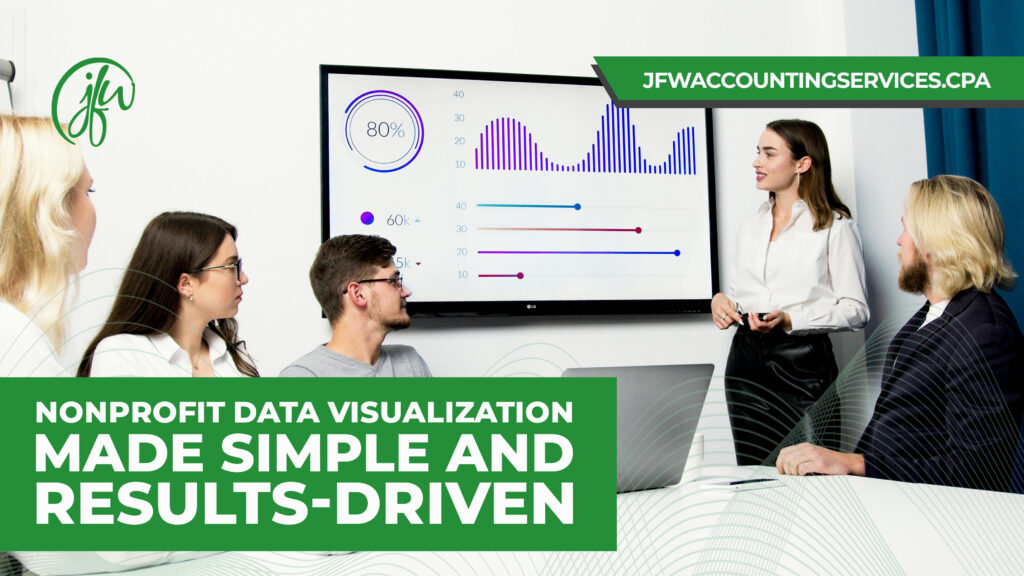Nonprofit data visualization has become an essential method for turning raw data into actionable insights, enabling organizations to improve financial management and communicate their results effectively. Presenting intricate financial information in clear, visual formats enables organizations to streamline reporting, enhance decision-making, and communicate their impact more effectively. This approach simplifies data interpretation and fosters stronger stakeholder connections through compelling visual narratives.
In this article, we will explore the growing importance of data visualization, its benefits in nonprofit financial reporting, and best practices for leveraging it to tell meaningful stories that drive mission success.
The Need for Data Visualization in Nonprofits
Nonprofits often face significant challenges with financial reporting. In particular, they must manage complex data while also addressing the lack of real-time insights. These issues can make it difficult for organizations to communicate progress effectively, maintain transparency, and meet the demands of various stakeholders. Under pressure to deliver accurate and efficient reports, nonprofit finance teams need tools that go beyond traditional spreadsheets.
This is where nonprofit data visualization plays a transformative role. By turning raw numbers into graphs, charts, and infographics, organizations can present their data in a clear, engaging, and actionable way. These visual tools enhance accountability and compliance and build trust by demonstrating measurable progress toward goals. Furthermore, nonprofit data visualization empowers leaders to uncover valuable insights. As a result, they can make informed decisions that align with their mission and inspire confidence among donors, supporters, and communities.
Key Benefits of Nonprofit Data Visualization
Clarity and Simplicity
Nonprofit data visualization simplifies the process of interpreting complex financial information. Instead of poring over endless spreadsheets, finance teams can use tools like graphs, charts, and infographics to present data in a clear, easily digestible manner. For instance, a grant manager can quickly assess program funding allocations and expenses through a visual chart, thus enabling them to identify discrepancies or inefficiencies at a glance. This streamlined approach saves time and allows staff to focus on higher-priority tasks.
Better Stakeholder Communication
Visual storytelling is a powerful way to communicate with boards, donors, and staff, ensuring everyone is aligned with the organization’s goals. Nonprofit data visualization enhances presentations by transforming raw data into compelling visuals that illustrate trends and achievements. For instance, during a donor presentation, a nonprofit might first showcase a line graph comparing annual fundraising growth and then follow it with a pie chart highlighting the impact of donor contributions. These visuals engage stakeholders and make complex information more accessible and persuasive.
Improved Decision-Making
Data visualization empowers nonprofit leaders to spot trends, analyze patterns, and plan strategically. Real-time charts and graphs enable organizations to monitor program outcomes, track key performance indicators, and allocate resources more effectively. For example, a nonprofit that tracks participant demographics and satisfaction rates can use visual dashboards to identify underperforming programs. Consequently, they can make data-driven adjustments to improve those programs. This proactive approach helps optimize operations and align efforts with the organization’s mission.
Enhanced Transparency and Trust
Clear, visually appealing financial reports build trust among stakeholders by showcasing the organization’s performance and accountability. By visualizing key metrics—such as revenue versus expenses or program success rates—nonprofits provide donors and grantors with the transparency they expect. These visuals demonstrate how resources are used and highlight the organization’s commitment to achieving its objectives, fostering confidence and long-term support.
Best Practices for Implementing Data Visualization
Implementing nonprofit data visualization effectively requires a strategic approach to ensure it delivers meaningful insights and engages stakeholders. By following these best practices, nonprofits can therefore make their visual data tools more impactful and better aligned with their mission.
Choose the Right Tools
Selecting the appropriate software is crucial for creating clear and functional data visualizations. Tools like Sage Intacct, Tableau, and Canva cater specifically to nonprofits by offering features such as interactive dashboards, prebuilt templates, and real-time data integration. However, before deciding on a platform, be sure to evaluate your organization’s needs, data complexity, and team expertise.
Focus on Relevant Metrics
Above all, prioritize key performance indicators (KPIs) that reflect your nonprofit’s goals, such as fundraising efficiency, donor retention, and program spending. Focusing on metrics that matter ensures your visualizations resonate with stakeholders and drive actionable insights.
Keep It Simple
Avoid cluttering dashboards with excessive data. Simplicity is key to making visualizations understandable at a glance. Use clean layouts, consistent color schemes, and clear labels to ensure your visuals communicate effectively without overwhelming viewers.
Use Visual Storytelling
Combine data points with compelling narratives to create a powerful story. For instance, combine graphs with testimonials to illustrate how donor contributions have directly impacted program success, thus giving supporters a clearer, more compelling view of their impact. This approach makes information memorable, engaging, and persuasive, inspiring stakeholders to take action.
By implementing these best practices, nonprofits can leverage data visualization to streamline reporting, enhance decision-making, and communicate their mission with greater clarity and impact.
Real-Life Examples of Nonprofit Data Visualization
Nonprofit data visualization transforms how organizations analyze and present financial and operational performance. By leveraging innovative tools, nonprofits can gain deeper insights, improve decision-making, and effectively communicate their results. Here are two examples of how nonprofits use data visualization to enhance their reporting and strategy:
Predictive Revenue and Expense Analysis
Modern tools like Sage Intacct Interactive Visual Explorer enable nonprofits to forecast future trends with ease. Predictive analytics allows finance teams to visualize revenue and expenses over time, helping them identify potential shortfalls or growth opportunities. This proactive approach empowers leaders to allocate resources strategically and ensure financial stability.
Outcomes Dashboard Drilldown
Dashboards tailored to nonprofit goals provide quick, at-a-glance insights. Moreover, they allow users to drill down into specific metrics. For example, an outcomes dashboard can visually track program effectiveness by integrating data such as participant demographics, success rates, and funding allocations, thus giving stakeholders a clearer picture of where improvements or investments are needed. This detailed visibility helps organizations showcase their impact to stakeholders and refine their programs for greater effectiveness.
These real-life applications of nonprofit data visualization demonstrate its potential to uncover actionable insights and enhance transparency.
Challenges and Solutions in Adopting Data Visualization
Nevertheless, adopting nonprofit data visualization often comes with challenges, including high costs, technical skill gaps, and resistance to change. Many nonprofits operate on tight budgets, making it difficult to invest in advanced visualization tools. Furthermore, staff may lack the expertise required to create and interpret visual data effectively. Meanwhile,organizational inertia can hinder the adoption of new technologies.
To overcome these challenges, nonprofits can start with affordable tools like Canva or Google Sheets and invest in user-friendly software like Sage Intacct or Tableau for more advanced needs. By providing staff with training on data visualization techniques and starting with simple projects before scaling up, nonprofits can ultimately ease the transition and ensure successful implementation.
Conclusion
Nonprofit data visualization offers powerful benefits, from simplifying complex data to enhancing stakeholder communication and decision-making. As a result of following best practices and overcoming implementation challenges, nonprofits can leverage data visualization to make their financial reporting more effective and engaging.
Now is the time to explore tools and strategies that align with your nonprofit’s goals. Adopting data visualization is not just a technical improvement—it’s a vital step toward telling your story with clarity and inspiring action to achieve your mission. Contact us today!

Jo-Anne Williams Barnes, is a Certified Public Accountant (CPA) and Chartered Global Management Accountant (CGMA) holding a Master’s of Science in Accounting (MSA) and a Master’s in Business Administration (MBA). Additionally, she holds a Bachelor of Science (BS) in Accounting from the University of Baltimore and is a seasoned accounting professional with several years of experience in the field of managing financial records for non-profits, small, medium, and large businesses. Jo-Anne is a certified Sage Intacct Accounting and Implementation Specialist, a certified QuickBooks ProAdvisor, an AICPA Not-for-Profit Certificate II holder, and Standard for Excellence Licensed Consultant. Additionally, Jo-Anne is a member of American Institute of Certified Public Accountant (AICPA), Maryland Association of Certified Public Accountants (MACPA), and Greater Washington Society of Certified Public Accountants (GWSCPA) where she continues to keep abreast on the latest industry trends and changes.

